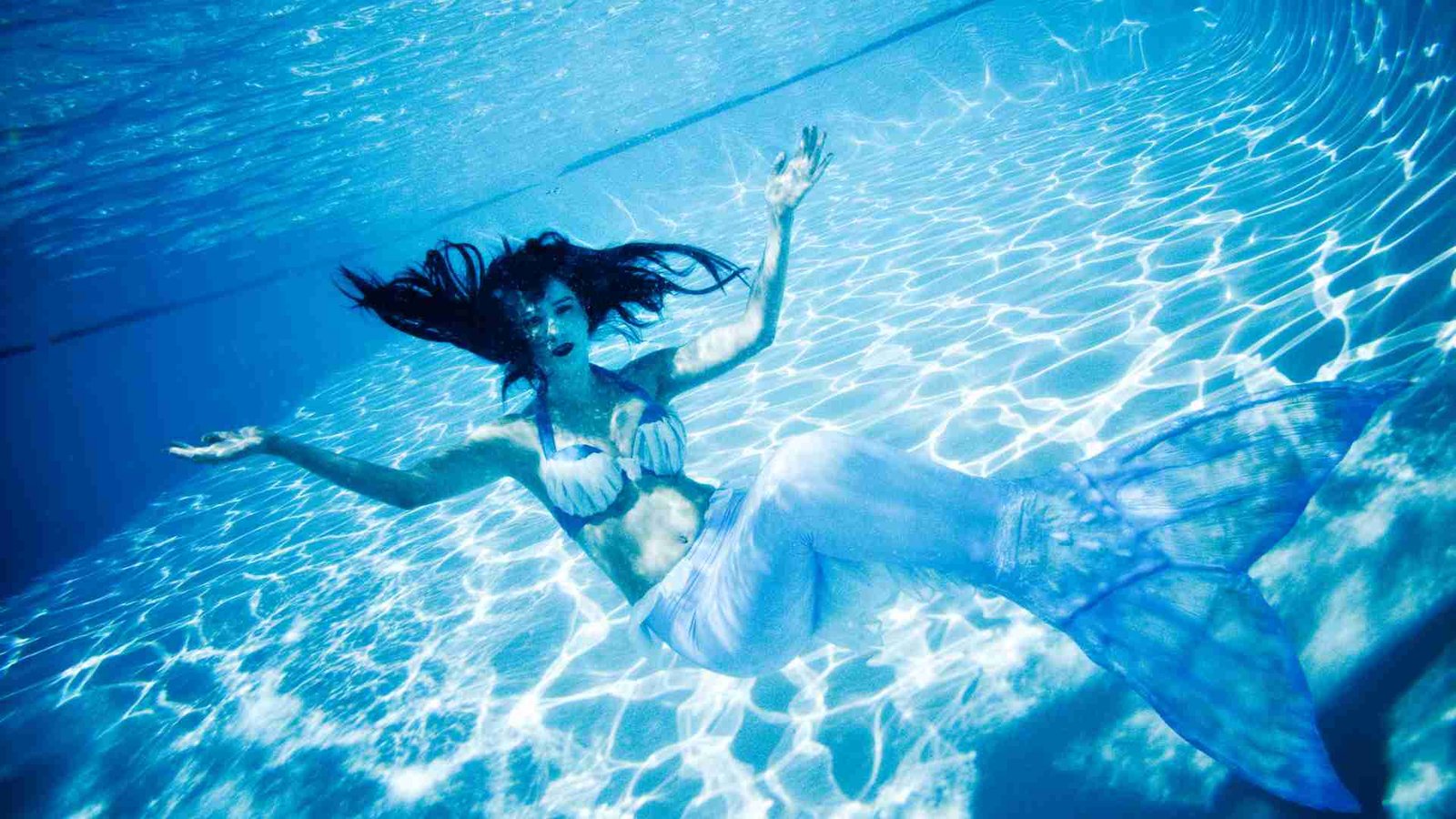
The Art of Underwater Nude Photography: A Complete Guide
There’s something almost magical about Underwater Nude Photography. It’s not just about taking pictures of the human body in water – it’s about capturing freedom, calm, and movement in their purest form. When you combine the beauty of the human figure with the fluid motion of water, you get images that look weightless, soft, and completely different from anything shot on land.
In this guide, we’re going to explore everything about Underwater Nude Photography – what it really is, how to prepare for it, what gear you’ll need, how to direct and light your shots, and how to make those images look stunning in post-production. Whether you’re a beginner curious about the art form or an experienced photographer looking to refine your skills, this guide will give you the complete picture.
And if you need help polishing or retouching your photos after your shoot, you can always rely on aitinsider – we specialize in professional image editing services for photographers, brands, and creatives like you.
What Makes Underwater Nude Photography So Special
Underwater Nude Photography is unlike any other type of portrait photography. The absence of gravity lets your subject move freely – almost like they’re floating in a dream. Hair drifts, fabric flows, and light bends in unexpected ways. The result? Images that look serene, intimate, and surreal at the same time.
The beauty of this art form lies in its subtlety. You don’t need to reveal everything to tell a story. The focus is on shapes, movement, and the emotion that water adds to the human body. It’s often less about sensuality and more about freedom, vulnerability, and artistic expression.
This is why Underwater Nude Photography has become so popular among fine-art photographers. It blurs the line between realism and imagination – between what’s seen and what’s felt.

Getting Ready for the Shoot
Before diving into the water (literally), preparation is everything. Underwater Nude Photography requires more planning than a regular shoot because you’re working in an unpredictable environment. The right preparation helps you keep the session safe, comfortable, and creative.
Choose the Right Location
Start with a pool if you’re new to this. Pools are controlled environments – clear water, even lighting, and predictable conditions. Once you’re comfortable shooting underwater, you can experiment in natural locations like lakes or the ocean.
When choosing your spot, make sure the water is clean and the depth is manageable. The model should be able to surface easily between shots. Safety always comes first.
Discuss Comfort and Boundaries
Since this type of photography involves nudity, communication is key. Talk openly with your model about poses, comfort levels, and privacy. A relaxed model will always give more natural, graceful poses underwater.
If it’s your first time working together, do a few test shots above water first. Build trust and make sure your subject feels confident before submerging.
Plan the Look and Feel
Decide on the mood you want to create – calm, dreamy, mysterious, or powerful. Everything from lighting to fabric choice affects the final image. Some photographers use flowing fabric or sheer materials to add motion and depth without distracting from the natural form.
If you’re planning to use props, make sure they’re safe to bring underwater and won’t damage your equipment or pool.
The Equipment You’ll Need
You don’t need the most expensive camera in the world to shoot Underwater Nude Photography, but you do need reliable gear.
Camera and Housing
A DSLR or mirrorless camera that can shoot in RAW is ideal. Pair it with a waterproof housing – not just a plastic bag cover, but one that’s made specifically for your camera model. Brands like Nauticam, Ikelite, or Sea & Sea make excellent options.
Make sure all seals are tight and test your housing in shallow water before putting your camera inside for a full shoot.
Lighting
Natural light can be breathtaking underwater, especially during midday when sunlight pierces the surface. However, if you’re shooting deeper or indoors, consider using waterproof strobes or continuous LED lights. Soft light works best because harsh flashes can create unwanted reflections.
Lenses and Accessories
A wide-angle lens lets you capture full-body shots and movement. Avoid zooming underwater – it’s harder to control. Some photographers also bring small weights to help models stay submerged more easily.
And yes – don’t forget cleaning kits and microfiber cloths. Water spots and fogged lenses can ruin great shots.
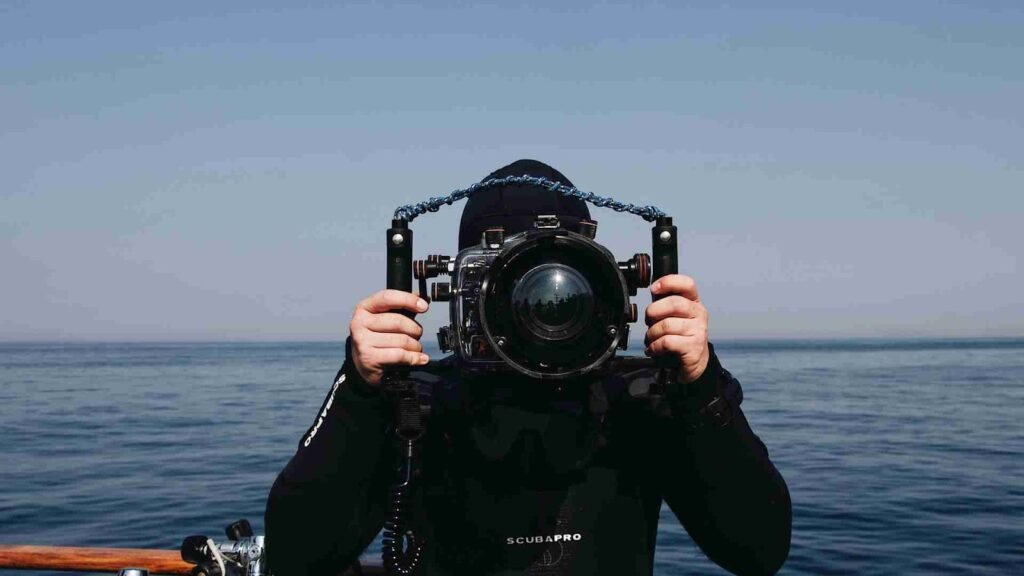
Shooting Techniques for Stunning Results
Now comes the fun part – capturing the actual images. Underwater Nude Photography is all about patience, rhythm, and anticipation. Water moves slowly, and so should you.
Communication Is Everything
Since you can’t talk underwater, use hand signals. Before shooting, practice simple cues like “move up,” “turn,” or “hold pose.” If your model feels unsure, let them surface often to rest and reset.
Focus on Movement, Not Perfection
Perfect poses don’t exist underwater. The beauty comes from organic movement – hair swirling, fabric floating, limbs drifting gracefully. Encourage your subject to move naturally instead of trying to “pose.”
Capture sequences instead of single shots. Later, when you review your images, you’ll find beautiful moments hidden between transitions.
Play with Angles and Light
Try shooting upward toward the surface – you’ll get gorgeous light patterns and bubbles that frame the subject beautifully. You can also experiment with reflections on the water’s surface or shoot near the bottom to create grounding shadows.
Light behaves differently underwater, so always check your exposure and color balance. Warmer tones often get lost, which is why post-editing becomes so important.
Editing and Post-Processing
Once your underwater session is done, it’s time to bring those images to life through editing. Post-processing is where Underwater Nude Photography truly shines – you can enhance colors, soften tones, and balance exposure to recreate the feeling you experienced in the water.
At aitinsider, we specialize in professional image editing services that make underwater photos look their best. Whether you need color correction, skin retouching, background cleanup, or light enhancement, our editors can help you refine your shots while preserving their natural beauty.
Editing underwater images often involves:
- Correcting color loss (especially reds and oranges that fade underwater)
- Adjusting contrast and exposure
- Enhancing clarity without over-sharpening
- Removing bubbles or debris that distract from the subject
- Retouching skin naturally to maintain realism
Good editing keeps the image soft yet detailed, airy yet defined – much like the atmosphere of water itself.
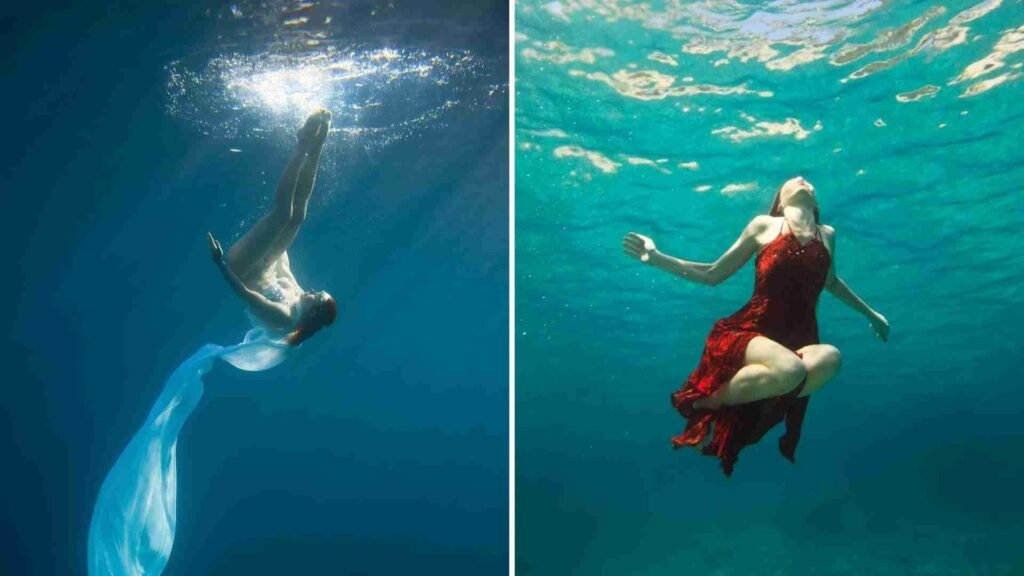
Creative Direction: Turning Ideas into Underwater Art
One of the most exciting things about Underwater Nude Photography is how limitless your creative direction can be. Water lets you tell stories that wouldn’t make sense on land – stories about dreams, rebirth, peace, freedom, or even surreal transformation.
Before you begin your shoot, visualize your concept like a short movie. Ask yourself:
- What emotion do I want to capture?
- Should the atmosphere feel calm or powerful?
- What kind of light and colors would express that mood?
For example, soft blue lighting with slow floating movements creates a peaceful and meditative feel. On the other hand, shooting in darker water with strong shadows gives a mysterious or moody effect.
You can even experiment with colored fabrics or underwater smoke effects (made safe for pools). These add texture and motion, making your Underwater Nude Photography stand out.
Making the Model Feel Comfortable
Since Underwater Nude Photography involves vulnerability, it’s essential that the model feels safe and respected. A comfortable environment always produces more natural, graceful results.
Start by explaining everything before the session – how long the model will stay underwater, what hand signals you’ll use, and where they can surface for air. It’s also a good idea to have a friend or assistant as a safety watcher above the surface.
Keep the water temperature comfortable – if it’s too cold, muscles tighten and poses look stiff. Encourage breaks, hydrate often, and never rush.
You’ll find that when the model relaxes, the photos instantly improve. The natural expressions, flowing hair, and gentle movements tell the story without forcing it.
Understanding Light and Color Underwater
Light behaves differently underwater than in the air. It bends, scatters, and loses certain colors the deeper you go. Reds and oranges fade first, which is why some underwater photos look bluish or greenish straight out of the camera.
To get the best results in Underwater Nude Photography, try shooting when sunlight is bright but not harsh – around midday for open water, or with diffused light if you’re in a pool. If you’re using artificial lights, position them carefully to avoid backscatter (tiny reflections from water particles).
Remember that the surface can be your friend – sunlight bouncing off the water creates beautiful ripple patterns on the skin. Move your subject slightly to play with those reflections.
Later, in editing, you can restore warmth and adjust tones so the skin looks natural again. Tools like Lightroom or Photoshop are great for this, or you can save time by outsourcing your retouching to aitinsider, where our editors specialize in restoring perfect underwater tones.
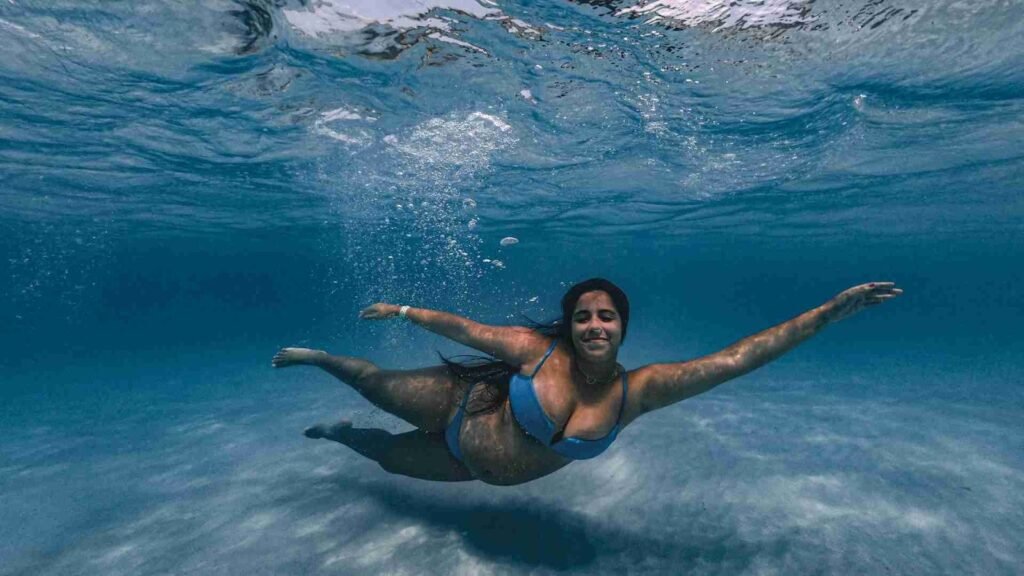
Composition Tips That Elevate Your Shots
A strong composition is what separates ordinary underwater shots from breathtaking ones. Here are a few principles to keep in mind (without turning this into a technical lecture).
Think about flow – literally. Water creates curves and waves, so use that motion in your frame. If the model’s body or fabric follows that flow, your image feels more natural.
Try shooting from below – this perspective often gives the model a powerful, goddess-like presence. Shooting toward the surface also captures the magic of light shimmering through.
And don’t forget negative space. Empty blue or teal backgrounds make the subject stand out dramatically. Sometimes less is more – a single pose in still water can be far more emotional than a busy scene.
You can even incorporate the surface itself into your shot – reflections of the body on the underside of the water can look like a painting. This is one of the reasons why Underwater Nude Photography feels almost surreal – it breaks the rules of gravity and balance.
Post-Processing Like a Pro
After shooting, post-processing is where the transformation happens. Even great underwater shots often look dull before editing, because of how light behaves underwater.
When editing your Underwater Nude Photography, start by adjusting white balance to fix color shifts. Then bring back warmth and clarity without overdoing it. Reduce haze, fine-tune shadows, and restore skin tones so they look lifelike again.
If you’re new to editing, this part can feel overwhelming – but that’s where professionals like aitinsider come in. Our image editing services are built for photographers who want to spend less time behind a computer and more time shooting. We can handle everything from natural skin retouching to color correction and background cleanup, ensuring your underwater shots look magazine-ready.
A good rule of thumb is to keep your edits subtle. The beauty of underwater images lies in their softness – so avoid making them too sharp or too saturated. Keep the dream alive.
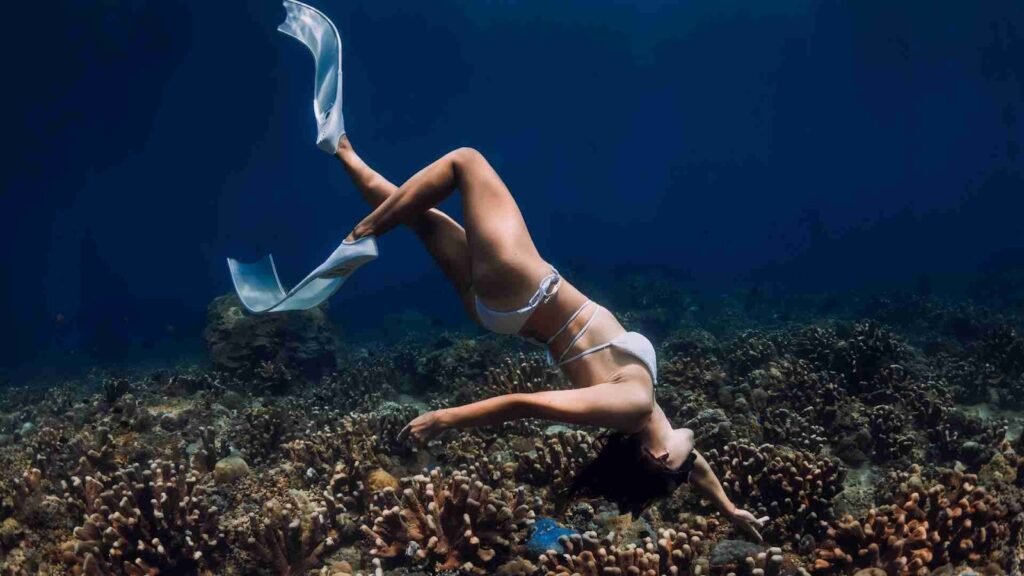
Common Mistakes to Avoid
Even seasoned photographers make mistakes in Underwater Nude Photography. Here are some common ones you can easily avoid.
One big issue is poor visibility. Cloudy water or floating debris can ruin the clarity of your shot. Always check water quality before shooting.
Another mistake is rushing the session. Working underwater takes patience. If you rush, you’ll miss those delicate moments where movement and light align perfectly.
Also, avoid over-directing the model. Water changes everything – poses that work on land may look awkward underwater. Let the model move naturally and capture in-between moments instead of rigid poses.
Lastly, don’t skip post-production. Even if you prefer a natural style, gentle adjustments in color and contrast can bring your photo to life.
The Ethics and Sensitivity of Nude Work
It’s worth emphasizing that Underwater Nude Photography should always be handled with respect and professionalism. Consent, comfort, and communication are non-negotiable.
Discuss boundaries, usage rights, and how the images will be shared before you begin. Always make sure your model feels fully in control. That’s how trust is built – and trust is what allows you to capture genuine, beautiful expressions.
Handled respectfully, this kind of photography becomes a celebration of human beauty and creative freedom, not exploitation.
Bringing It All Together
At its heart, Underwater Nude Photography is about more than technique – it’s about emotion. The water becomes your canvas, the body becomes the brushstroke, and light becomes the paint. When these elements merge, the result is pure art.
You don’t need a massive studio setup or years of experience to start. What you need is curiosity, patience, and the willingness to experiment. The first few tries might not be perfect, but that’s part of the learning process.
As you explore deeper, you’ll discover that this genre is not just about creating images – it’s about experiencing calm, creativity, and connection through water.
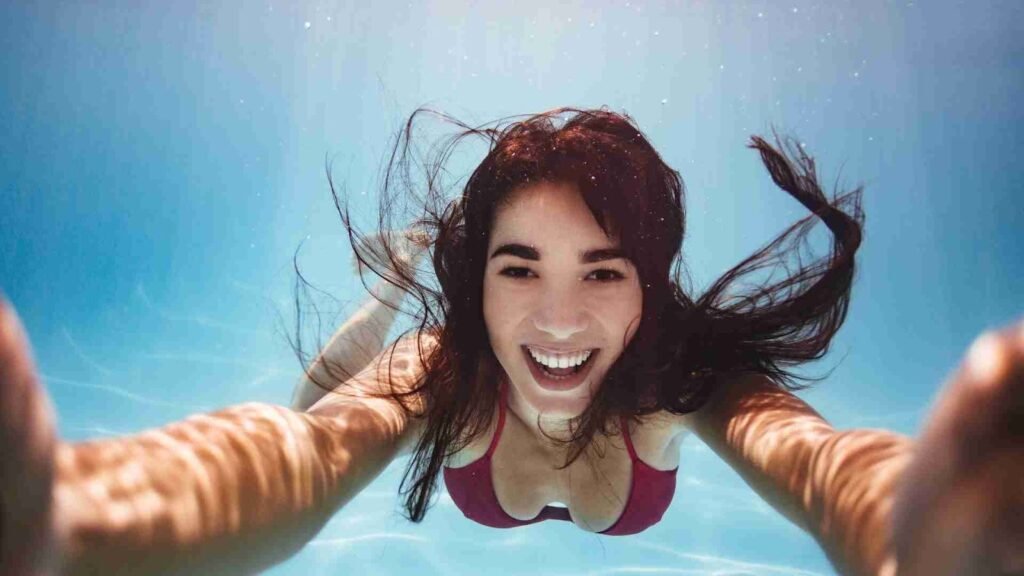
Final Thoughts
Underwater Nude Photography combines art, emotion, and technical skill in one breathtaking package. It’s a journey where you learn to see light differently, to understand movement beyond gravity, and to appreciate how vulnerability becomes beauty when handled with care.
If you’re serious about improving your results, don’t underestimate the power of professional post-editing. At aitinsider, our team can help you enhance your underwater shots – adjusting tones, perfecting colors, and retouching skin naturally so your work looks clean and professional while keeping your artistic intent intact.
So go ahead – grab your camera, find your water, and start experimenting. The art of Underwater Nude Photography is waiting for you to explore it. Once you dive in, you’ll never look at photography the same way again.
